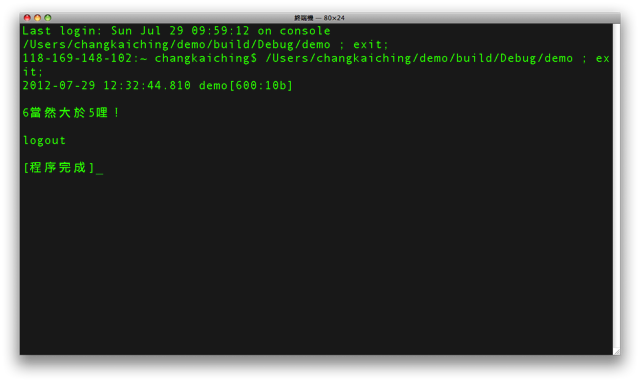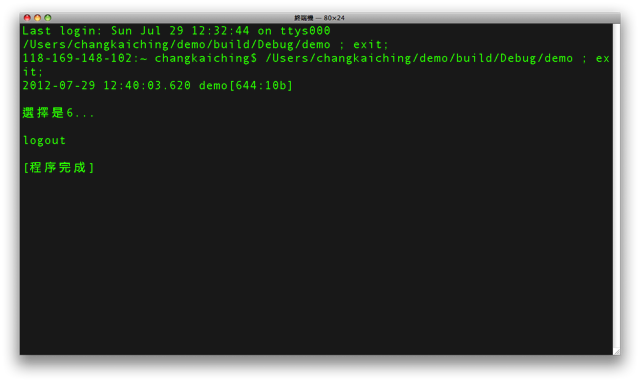
選擇結構有單一選擇跟多重選擇,兩者都可使用 if 陳述 (if statement) , if 為關鍵字 (keyword) 之一,若是多重選擇 if 須與 else 連用。單一選擇,也就是單獨使用 if 陳述如下
if (3 > 5) { NSLog(@"喔,3大於5發生了!");} |
以上條件為 3 大於 5 ,如果 3 大於 5 為真,程式就會執行條件後的大括弧的程式區塊 (block) ,如果 3 大於 5 為假,程式自然跳過條件後的程式區塊,去找區塊後的第一個陳述 (statement) 執行。
if 與 else 連用,條件為真,執行 if 後的程式區塊,條件為假,就執行 else 後的程式區塊
if (3 > 5) { NSLog(@"喔,3大於5發生了!");}else { NSLog(@"還好,3沒有大於5!");} |
if-else 也可以多個連用,形成 if-else if-else 的多重選擇,最後的 else 表示以上皆非
if (3 > 5) { NSLog(@"喔,3大於5發生了!");}else if (4 > 5) { System.out.println("喔,4大於5發生了!");}else if (5 > 5) { NSLog(@"喔,5大於5發生了!");}else if (6 > 5) { NSLog(@"6當然大於5哩!");}else { NSLog(@"以上沒有符合的條件 :(");} |
我們將以上寫成完整的範例程式,如下
1 2 3 4 5 6 7 8 9 10 11 12 13 14 15 16 17 18 19 20 21 22 23 24 25 26 27 28 29 30 31 32 33 34 35 36 37 | // 示範 if-else 的類別#import <Foundation/Foundation.h>int main (int argc, const char * argv[]) { NSAutoreleasePool * pool = [[NSAutoreleasePool alloc] init]; NSString *output = @"\n\n"; [output autorelease]; if (3 > 5) { output = [output stringByAppendingString: @"喔,3大於5發生了!"]; } else if (4 > 5) { output = [output stringByAppendingString: @"喔,4大於5發生了!"]; } else if (5 > 5) { output = [output stringByAppendingString: @"喔,5大於5發生了!"]; } else if (6 > 5) { output = [output stringByAppendingString: @"6當然大於5哩!"]; } else { output = [output stringByAppendingString: @"以上沒有符合的條件 :("]; } output = [output stringByAppendingString: @"\n\n"]; NSLog(output); [pool drain]; return 0;}/* 《程式語言教學誌》的範例程式 檔名:selectiondemo.m 功能:示範 Objective-C 程式 作者:張凱慶 時間:西元 2012 年 7 月 */ |
編譯 (compile) 後執行,如下

if-else if-else 多重選擇的缺點是需要很多個條件,程式需要做很多個條件判斷,因此另外有個 switch 陳述 (switch statement) ,條件為一個常數 (constant) 值,然後程式自動尋找符合的 case 。同樣的 switch 、 case 也都是關鍵字
switch (6) { case 3: System.out.println("選擇是3..."); break; case 4: System.out.println("選擇是4..."); break; case 5: System.out.println("選擇是3..."); break; case 6: System.out.println("選擇是6..."); break; default: System.out.println("以上沒有符合的條件 :(");} |
這裡, switch 後面的小括弧必須是常數值,此例中直接使用常數 (constant) ,也可以使用有常數值的變數 (variable) 。 case 後空一格,然後也是接常數值,通常就是直接填入符合情況的字面常數,注意,每個 case 的常數後都要接冒號。
case 底下的陳述,習慣上沒有用大括弧,而是用縮排 (indentation) 的方式表示屬於哪個 case 的工作。每個 case 最後,我們都有加上 break 陳述 (break statement) ,這是中斷跳出執行的意思,就是說,這個 case 符合並且執行了 case 所屬的工作,到此跳出 switch-case 的範圍,程式繼續執行switch 大括弧後的陳述。
switch-case 最下面有個 default , default 就是預設情況,如果以上皆非就會執行 default 的工作,這跟 if-else if-else 最後的 else 的用法相同。但是,如果 case 後沒有 break ,每一次執行 default 都會被執行。同樣的, break 與 default 也都是關鍵字之一。
我們將此例寫成完整的範例程式,如下
1 2 3 4 5 6 7 8 9 10 11 12 13 14 15 16 17 18 19 20 21 22 23 24 25 26 27 28 29 30 31 32 33 34 35 36 37 38 39 40 41 42 | // 示範 switch-case 的類別#import <Foundation/Foundation.h>int main (int argc, const char * argv[]) { NSAutoreleasePool * pool = [[NSAutoreleasePool alloc] init]; NSString *output = @"\n\n"; [output autorelease]; switch (6) { case 3: output = [output stringByAppendingString: @"選擇是3..."]; break; case 4: output = [output stringByAppendingString: @"選擇是4..."]; break; case 5: output = [output stringByAppendingString: @"選擇是5..."]; break; case 6: output = [output stringByAppendingString: @"選擇是6..."]; break; default: output = [output stringByAppendingString: @"以上沒有符合的條件 :("]; } output = [output stringByAppendingString: @"\n\n"]; NSLog(output); [pool drain]; return 0;}/* 《程式語言教學誌》的範例程式 檔名:switchdemo.m 功能:示範 Objective-C 程式 作者:張凱慶 時間:西元 2012 年 7 月 */ |
編譯後執行,如下

複合陳述 (compound statement) 除了選擇結構 (selection structure) 還有重複結構 (repetition structure) ,重複結構也被稱為迴圈 (loop) ,接下來我們就來看看如何使用迴圈吧!
| 中英文術語對照 | |
|---|---|
| 選擇 | selection |
| 條件 | condition |
| if 陳述 | if statement |
| 關鍵字 | keyword |
| 區塊 | block |
| 陳述 | statement |
| 編譯 | compile |
| switch 陳述 | switch statement |
| 常數 | constant |
| 變數 | variable |
| 縮排 | indentation |
| break 陳述 | break statement |
| 複合陳述 | compound statement |
| 選擇結構 | selection structure |
| 重複結構 | repetition structure |
| 迴圈 | loop |
您可以繼續參考
基礎篇
相關目錄
Objective-C 入門指南
Objective-C 教材
首頁
參考資料
Learning Objective-C: A Primer
The Objective-C Programming Language
Cocoa Fundamentals Guide
Coding Guidelines for Cocoa
Advanced Memory Management Programming Guide
Archives and Serializations Programming Guide
沒有留言:
張貼留言